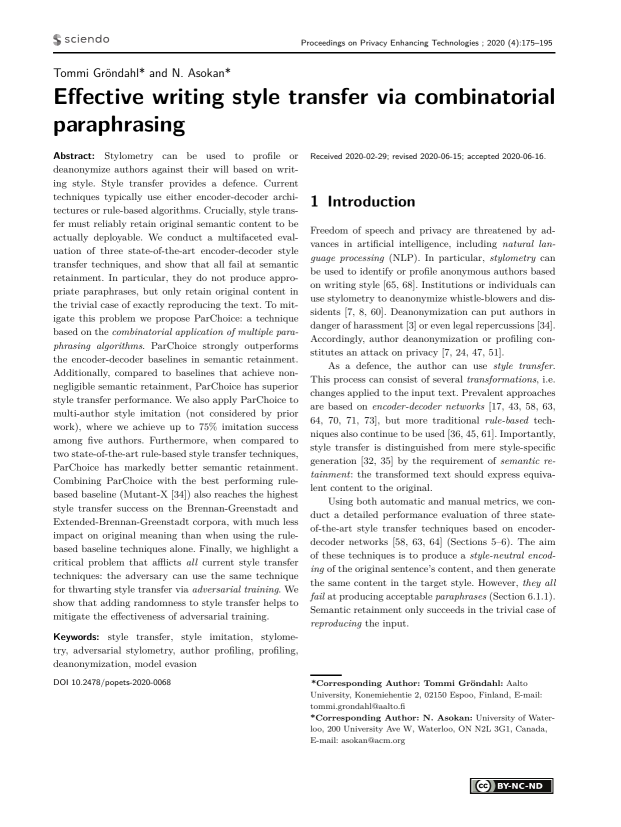Effective writing style transfer via combinatorial paraphrasing
Authors: Tommi Gröndahl (Aalto University, Konemiehentie 2, 02150 Espoo, Finland), N. Asokan (University of Waterloo, 200 University Ave W, Waterloo, ON N2L 3G1, Canada)
Volume: 2020
Issue: 4
Pages: 175–195
DOI: https://doi.org/10.2478/popets-2020-0068
Abstract: Stylometry can be used to profile or deanonymize authors against their will based on writing style. Style transfer provides a defence. Current techniques typically use either encoder-decoder architectures or rule-based algorithms. Crucially, style transfer must reliably retain original semantic content to be actually deployable. We conduct a multifaceted evaluation of three state-of-the-art encoder-decoder style transfer techniques, and show that all fail at semantic retainment. In particular, they do not produce appropriate paraphrases, but only retain original content in the trivial case of exactly reproducing the text. To mitigate this problem we propose ParChoice: a technique based on the combinatorial application of multiple paraphrasing algorithms. ParChoice strongly outperforms the encoder-decoder baselines in semantic retainment. Additionally, compared to baselines that achieve nonnegligible semantic retainment, ParChoice has superior style transfer performance. We also apply ParChoice to multi-author style imitation (not considered by prior work), where we achieve up to 75% imitation success among five authors. Furthermore, when compared to two state-of-the-art rule-based style transfer techniques, ParChoice has markedly better semantic retainment. Combining ParChoice with the best performing rulebased baseline (Mutant-X [34]) also reaches the highest style transfer success on the Brennan-Greenstadt and Extended-Brennan-Greenstadt corpora, with much less impact on original meaning than when using the rulebased baseline techniques alone. Finally, we highlight a critical problem that afflicts all current style transfer techniques: the adversary can use the same technique for thwarting style transfer via adversarial training. We show that adding randomness to style transfer helps to mitigate the effectiveness of adversarial training.
Keywords: style transfer, style imitation, stylometry, adversarial stylometry, author profiling, profiling, deanonymization, model evasion
Copyright in PoPETs articles are held by their authors. This article is published under a Creative Commons Attribution-NonCommercial-NoDerivs 3.0 license.


